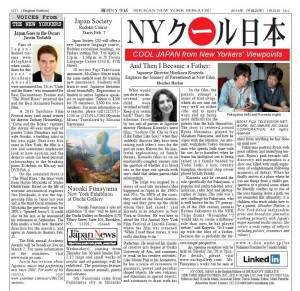Justin’s Japan: Nippon in New York — ‘Dragon Ball’ in Color, Lolita Fashions, ONE OK ROCK’s Debut
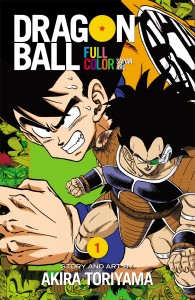
Dragon Ball Full Color makes its English-language debut in print and digital Feb. 4. (VIZ Media LLC)
By JQ magazine editor Justin Tedaldi (CIR Kobe-shi, 2001-02) for Examiner.com. Visit his Japanese culture page here for related stories.
Stay warm this winter with some hot local events, from the debut performance of one of Japan’s most successful live acts, another performance from one of the country’s biggest crossover stars, and an annual showcase that brings the sights (and tastes) of Japan to vivid life.
This month’s highlights include:
Saturday, Feb. 1, 6:00 p.m.
Asia Society, 725 Park Avenue
Free
The final entry of the film series Vengeance Is Shohei Imamura! Yasuko was exposed to black rain, the radioactive fallout from the atomic bomb dropped on Hiroshima. Years later, she and her townsmen continue to rebuild their life and endure the aftermath. At an age ripe for marriage, Yosuko has been rejected by man after man for fear of radiation, even though she has shown no signs of any illness. The film juxtaposes present-day struggles with flashbacks to scenes of wartime devastation. A departure from Imamura’s usual interest in bawdy human behavior, this film brings him closer to his early mentor Ozu, who is known for his restrained and subdued study of quiet dignity and for whom Imamura acted as assistant director.
Tuesday, Feb. 4
Dragon Ball Full Color, Volume 1
$19.99 MSRP
Akira Toriyama’s epic manga series—one of the most popular of all time—makes its English-langage debut in full color, graphic novel-size in print and digital editions! Son Goku is the greatest hero on Earth. Five years after defeating the demon king Piccolo, he’s grown up and has a family. But what is the real reason for Goku’s incredible strength? A visitor from outer space arrives bearing terrible news—Goku is an alien, and the visitor, Raditz, is Goku’s brother! When Raditz turns out to be a ruthless killer, Goku must fight his incredibly strong brother to save his family and the entire human race. A surprising alliance may be Earth’s last hope: Goku will team up with his old enemy Piccolo to save the world!
Tuesday, Feb. 4, 7:30 p.m.
Joe’s Pub, 425 Lafayette Street
$30 reserved, $35 premium
Akiko Yano returns to Joe’s Pub with her longtime New York friends/virtuoso musicians Will Lee and Chris Parker, answering overwhelming demand from the fans who caught their previous go-round in November 2012. See the pop and jazz chanteuse whom Jon Pareles of the New York Times calls “a world class songwriter with a clear, gentle, wide-ranging voice. She is also an accomplished, endearing performer who might be a Japanese Carole King, Joni Mitchell or Meredeith Monk…”
For the complete story, click here.
WIT Life #260: Shohei Imamura Film Festival at Asia Society
WIT Life is a periodic series written by professional Writer/Interpreter/Translator Stacy Smith (Kumamoto-ken CIR, 2000-03). She starts her day by watching Fujisankei’s newscast in Japanese, and here she shares some of the interesting tidbits and trends along with her own observations.
First of all, a belated 明けましておめでとうございます! It’s been a busy start to 2014, but I’m happy to be blogging again in the year of the horse (午年 or umadoshi). It being umadoshi is good news for people like me whose animal sign is the horse, as one is said to have good luck when the zodiac sign for the current year is the same as the one from the year when you were born. This makes me what is called a 年女 (toshi onna), and I’m hoping this year of the horse gives me faster feet in the many marathons I run…
In conjunction with the Japan Foundation, the Asia Society is currently featuring the Vengeance is Shohei Imamura film series from January 17-February 1. I have been a fan of Imamura’s ever since seeing The Eel (「うなぎ」, with Yakusho Koji playing a former convict) in 1997, and was glad to have the opportunity to check out some of his other flicks. He was the first Japanese director to win two Palme d’Or awards, one for Unagi, and one for The Ballad of Narayama (「楢山節考」) in 1983, screened this past Saturday night as part of the Imamura film festival.
Set in the 19th century, the movie takes place in a small rural Japanese village where they have Read More
Justin’s Japan: Japan Goes to the Oscars
By JQ magazine editor Justin Tedaldi (CIR Kobe-shi, 2001-02) for Shukan NY Seikatsu. Visit his Examiner.com Japanese culture page here for related stories.
Fans of Japan-themed cinema were delighted when candidates for this year’s Academy Awards were announced Jan. 16, as Cutie and the Boxer was nominated for Best Documentary Feature and The Wind Rises received the nod for Best Animated Feature Film.
A 2013 Sundance Film Festival entry (and award winner for director Zachary Heinzerling), Cutie and the Boxer captures the stormy 40-year marriage of painter Ushio Shinohara and his wife Noriko, a budding artist in her own right. Shot over five years in New York, the film is a raw and sometimes unpleasant look at how egotism and the desire to create can bend personal relationships to the breaking point. It will be released on Blu-ray and DVD Feb. 4.
On the animated front is The Wind Rises, the latest work from Hayao Miyazaki of Studio Ghibli fame. Based on the life of wartime aeronautical engineer Jiro Horikoshi, it was the top-grossing film in Japan last year and is the third Oscar nominee for Miyazaki (he previously won for 2001’s Spirited Away). It could also be his last, as he announced his retirement in September. The film receives a domestic theatrical release Feb. 21, and marks a bold new thematic direction for the maestro.
The 86th annual Academy Awards will be broadcast live on March 2. For more information on the nominees, visit www.oscar.go.com.
JQ Magazine: Film Review—Hirokazu Kore-eda’s ‘Like Father, Like Son’

“As in his other films, Kore-eda’s action unfolds in minute detail and slowly evolving scenes. His static camera and well-balanced visual frame reference Ozu, another director concerned with Japan’s modernization and the traditional family.” (© 2013 FUJI TELEVISION NETWORK, INC.AMUSE INC.GAGA CORPORATION. All rights reserved.)
By Lyle Sylvander (Yokohama-shi, 2001-02) for JQ magazine. Lyle has completed a master’s program at the School of International and Public Affairs at Columbia University and has been writing for the JET Alumni Association of New York since 2004. He is also the goalkeeper for FC Japan, a New York City-based soccer team.
The winner of the Jury Prize at the 2013 Cannes Film Festival, Hirokazu Kore-eda’s newest film, Like Father, Like Son, features a stronger narrative arc and story than his previous films, which include the metaphysically philosophical After Life and the naturalistic Ozu-like Nobody Knows. In fact, the film’s plot reads like a Hollywood high-concept pitch: two families discover that their children are not their own due to a switch at birth. Developing a “nature vs. nurture”-type approach to the subject, Kore-eda gives the families different socioeconomic backgrounds.
Ryota Nonomiya (Masaharu Fukuyama) is a high-achieving architect who lives in a modern Tokyo high-rise apartment with his wife Midori and their six-year-old son Keita (Keita Ninomiya). The other father, Yudai Saiki (Lily Franky), is a working class shopkeeper who lives on the outskirts of the city in a nondescript housing block with his wife Yukari (Yoko Maki) and the young Ryusei (Hwang Sho-gen). By presenting these two disparate backgrounds, Kore-eda examines the nature of father-son relationships and familial influence in modern Japan.
Much of the film’s action concerns the responses to the shocking new information. Do the families try and “switch” the children again so that the original wrong can be corrected? Now that they are inseparably involved in each others’ lives, do they try and raise the children together? Or do they simply carry on as before, complicit in their knowledge that neither child is living with his biological parents? Kore-eda examines each of these scenarios as the characters try to confront a situation that life has not prepared them for.
Justin’s Japan: ‘Evangelion: 3.0,’ Stanley Clarke Trio, K-pop Concert Debuts

Evangelion: 3.0 You Can (Not) Redo makes its New York theatrical debut at Big Cinemas Manhattan Jan. 10. (© khara. Licensed by FUNimation® Productions, Ltd. All Rights Reserved.)
By JQ magazine editor Justin Tedaldi (CIR Kobe-shi, 2001-02) for Examiner.com. Visit his Japanese culture page here for related stories.
Start 2014 off right by heading down to your local concert hall, cinema or arts center for some fantastic new year’s fare. Whether you enjoy cutting edge anime, a performance from Grammy-winning and pop sensations, or a classic film favorite of the legendary Donald Richie, treat yourself and catch a break from the cold.
This month’s highlights include:
Sunday, Jan. 5, 7:00 p.m.
MIKA Samba Jazz Trio
Somethin’ Jazz Club, 212 East 52nd Street, 3rd Floor
$12
Presented by Mar Creation, New York-based samba jazz pianist and recording artist MIKA will have her first concert in 2014 at midtown’s venerable Somethin’ Jazz Club, supported by Rafael Barata (drums) and Eduardo Belo (bass). A native of Rio de Janeiro, Barata brings the bossa nova, Belo brings the bottom, and MIKA knits it all together, evoking the warm, soothing sounds of Ipanema and beyond to kick off the new year in style.
Jan. 8-12
Niwa Gekidan Penino—The Room Nobody Knows
Japan Society, 333 East 47th Street
$28/$22 Japan Society members
North American debut! Two brothers inhabit a mysterious, dreamlike apartment. On the day of the elder’s birthday, the younger, who is supposed to be studying for college entrance exams, is preoccupied with creating unusual objects for the celebration. Meanwhile, in the upper room, the younger brother’s alter egos—derived from his wild imagination and taking the form of two creatures, one with a sheep’s head and another with pig features—help with the party preparations. Written and directed by psychiatrist turned most-talked-about theater artist Kuro Tanino and performed by his company Niwa Gekidan Penino, The Room Nobody Knows lures you into a weird yet funny world hidden deep within the Tokyo metropolis. Performed in Japanese with English subtitles. A MetLife Meet the Artists Reception follows the Jan. 8 performance.
Thursday, Jan. 9, 7:30 p.m.
Best Buy Theater, 1515 Broadway
$50-$180
Forming in their native South Korea in 2008 and big in Japan (where they have toured and released albums since 2011), boy band U-KISS is finally touring America for the very first time! U-KISS (an acronym for Ubiquitous Korean International Super Star) consists of members Kevin, Eli, AJ, Soohyun, Kiseop, and Hoon. The band will kick off a new series of concerts titled “THE HEADLINERS,” which promises to bring spectacular 360-degree content of these rising pop princes.
For the complete story, click here.
The 17th Japanese Film Festival in Australia wraps up after a mammoth tour around Australia. Eden Law (Fukushima JET 2010-2011, current member of JETAA NSW reviews some of the films that were on offer.

Is this organically-made?
This is a very Japanese melodrama, filled with messages about perseverance and dedication, themes that were common to many of this year’s film festival selection. The story of an apple farmer’s struggles to grow viable organic crops, it is actually based on a true story of Akinori Kimura and his wife Mieko Kimura, first popularized in a tv special and then a book (by the catchy title of “Kiseki no Ringo (Zettai Fukano) oh Kutsugaeshita Noka・ Akinori Kimura no Kiroku”) written about them by Takuji Ishikawa.
Son of an Aomori apple farming family, from an early age, Kimura (Sadao Abe) is shown to be an inveterate tinkerer, taking apart things to see how they work (although not so proficient on putting them back together again). Dissatisfied with the conservative and incurious mentality of his home town, he leaves for Tokyo for greater and better things, only to be ordered back to attend his own wedding arrangements to the local beauty, Mieko (Miho Kanno). Apparently this was enough to get Kimura to ditch his entire career in the city and settle down without complaints, to do the one thing he had scorned – apple farming, no doubt delighting his parents that their son is finally settling down and cleaving to his appropriate destiny. But then Kimura discovers that his young wife has a severe allergic reaction to all the chemical pesticides and fertilizers. So turning that curious tinker’s mind of his to the problem, he embarks on what will be a long and hard road to perfecting the perfect organic apple.
While the suffering and tribulations the Kimuras (they ended up having three daughters) endure are harsh, at times it seems so over the top that it veers closely into melodramatic territory. It’s hard to believe that the very young children shared in the suffering of their parents, for example, a sentiment echoed by Kimura’s best friend who at one point berate him severely for neglecting his daughter’s needs in a “selfish” pursuit of his dream. They have no electricity, nothing to eat, and Kimura has to take odd jobs in Tokyo to keep the family going, before losing it in a mugging – one disaster upon another. Abe’s portrayal of Kimura is also problematic, as the actor, whose cheerful face, while expressive enough to show a measure of unease beneath that ever-present smile, sometimes hits the wrong note and fails to convey the appropriate emotion that particular scenes call for. In these instances, Abe just seems at best a slightly confused person who knows that something is wrong but not entirely sure what, thereby lessening the emotional impact. It does admittedly, bring an extra level of tragedy to Kanno’s role as the long-suffering wife, who for whatever reason, continuously supports her husband through thick and thin; her acting range is decidedly broader and richer in depth. Tsutomu Yamazaki, as the wise father-in-law, in contrast, radiates such presence and dignity without having to do very much that he threatens to steal every scene he’s in. He’s the kind of strong, silent parental type that everyone wishes they have in real life.
However, it’s undeniable that it is quite a compelling story, and the Kimuras are such sympathetic characters that you can’t help but become invested in their struggles. The locations are extraordinarily beautiful, with Mt Iwaki in the background. And while I can’t be sure, I think the dialogue were spoken in Tohoku dialect, a delightful detail since I had lived in Tohoku for a time, and it certainly reinforces the bucolic country setting. Chosen to close the 17th Japanese Film Festival, it is an appropriate choice that echoes the festival’s theme of discipline, endurance and cooperation.
Fruits of Faith (Kiseki no Ringo) by Yoshihiro Nakamura, released June 8 2013 in Japan, starring Sadao Abe, Miho Kanno, Hiroyuki Ikeuchi, Takashi Sasano, Masato Ibu, Mieko Harada and Tsutomu Yamazaki.
The 17th Japanese Film Festival in Australia is now showing in Melbourne, the last major city on its national tour before wrapping up for the year. Eden Law (Fukushima JET 2010-2011, current member of JETAA NSW reviews some of the films on offer.
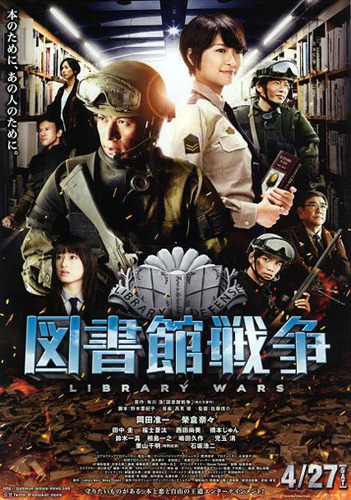
I said SHUSH MF!! * machine gun fire *
Library Wars (Toshokan Senso) is the latest in a series of adaptation of an extremely popular series of light novels by Hiro Arikawa, which has included your usual manga and anime. The inspiration for the plot comes from the real life Statement on Intellectual Freedom in Libraries of the Japan Library Association, which kind of sounds pretty bad-ass when you think about it. Especially when, interpreting its mission statement rather liberally to mean the right to bear arms. Armed librarians. Hate to think what the penalties for late returns would be.
Dealing with the theme of censorship, Japan in an alternate reality has gone overboard with outlawing ‘unsuitable’ reading material, raiding shops with maniacal book-burning zeal. But against this thought police are the librarians who form the defensive Librarian force, who take up arms to protect the citizens’ right and access to information. Joining the ranks is Iku Kasahara (Nana Eikura), who is your typical rough diamond – brash, impulsive, klutzy, a rule-breaker and therefore audience favourite. She continuously butts head against hard-arse Atsushi Dojo (Junichi Okada), a no-nonsense senior librarian who naturally, questions her place in the force. Around them, forces are on the move to consolidate and destroy books and knowledge, and the Library Force gears up for the ultimate confrontation.
This isn’t Fahrenheit 451, although there are some discussions about freedom of speech and an out of control state that doesn’t know where to draw the line in the name of protecting the hearts and minds of the nation from indecency and corruption. But for the most part, it’s largely kept light and focused on comedy and action, with recognizable character tropes from Japanese fiction. While it’s a pure escapism, some things are a bit far-fetched: you wonder why no one, in the year 2019, have thought about making backups, especially if these things are so precious, for example.
The cast perform their roles as expected, their characters doesn’t have much need for complex character development. Things like character quirks that might work in a novel or an anime situation don’t translate too well into a live-action film – Kasahara’s personality isn’t that endearing, and Dojo, as handsome as he is, is rather a one-note character. There’s obviously a lot that hasn’t been transferred from a wealth of source material into the short timeframe of a film. Although I must say Jun Hashimoto’s scenery chewing is one of the entertaining things to watch in this film (it’s like each facial muscle is working independently of each other). Things pick up in the last half as it’s action-packed, but the film is largely froth and would appeal the most to the fan base. Had it been a lot funnier, I might be more forgiving of some of the plot holes, but as such, while it isn’t bad, it’s just rather pedestrian and unmemorable.
Library Wars (Toshokan Senso) by Shinsuke Sato, released April 27 2013 in Japan, starring Junichi Okada, Nana Eikura, Kei Tanaka, Sota Fukushi, Chiaki Kuriyama, Kenji Takeyama, Iwao Nishina, Ryusuke Kenta and Maki Orikuchi.
The 17th Japanese Film Festival in Australia is now showing in Melbourne, the last major city on its national tour before wrapping up for the year. Eden Law (Fukushima JET 2010-2011, current member of JETAA NSW reviews some of the films on offer.

Will the real Hitoshi please stand up, please stand up?
This is film messed with my head. Escalating from a quirky, comedy of errors with eccentric characters to a disturbing, confusing movie where you feel like the character Hitoshi himself, running around wild-eyed in panic as you try to make sense of what’s going on – not that the film gives you any concrete answers.
But let’s start with a bit of a background. Hitoshi (Kazuya Kamenashi), a failed photographer, makes a living working in an electronics department, with fellow employees who are probably a little bit insane. Then one day, a stranger’s phone falls into his hands, and on impulse, Hitoshi takes the phone and scams the owner’s mother into depositing 900,000 yen into his bank account. And then that’s when shit gets weird.
The title “It’s Me, It’s Me” comes from the fact Hitoshi starts finding copies of himself popping up, each with his face but different name, different lifestyles – even of the opposite gender. It’s almost like seeing versions of himself – Kamenashi doesn’t just wear different wigs or clothes, or act differently; his face gets superimposed on wildly different body types like that scene from Being John Malkovich. Does each copy represent a possibility or alternate reality that could have been, had circumstances being different, or a choice decided in another way? Which is the real Hitoshi? Was there ever a real Hitoshi? I really don’t know – you tell me. At first finding other “me”s is fun – it’s like finding someone who truly understands you – but the initial novelty and fun of first discovery soon gives way to darker developments, as the initial group of Hitoshis realise that not every aspect of their personality is pleasant, or even desirable. Out of place objects then begin to appear in some scenes, such as overturned drums of strange viscous pink liquid crop up and disappear, posters of a pair of eyes stuck on walls appear to watch Hitoshi and his strange adventures – Miki’s mischievous and anarchic humour teases us as they appear and disappear in the film, like visual signposts of the upcoming weirdness that is about to unleash.
But in the meantime, we are distracted by the anarchic humour and fun by the assortment of characters and dialogue. Minor characters are invested with a huge amount of personality and energy, like Hitoshi’s original mum, Masae (Midoriko Kimura) who insists on being called by her name instead of “mother” because she decided it suits her more; his co-workers like the hyperactive Minami (Eri Fuse) and overbearing dorky manager Tajime (Ryo Kase) and sexy customer Sayaka (Yuki Uchida). Kamenashi juggles a huge amount of roles, portraying different minor characters who seem to be different kind of Japanese stereotypes, definitely working hard for his money.
You might find “Ore Ore” infuriating or intriguing, but it is a wild ride, throwing up all sorts of puzzling questions and frustrating vague hints as to the possible answers.
It’s Me, It’s Me (Ore Ore) by Satoshi Miki, released May 25th 2013 in Japan. Starring Kazuya Kamenashi, Yuki Uchida, Ryo Kase, Midoriko Kimura, Keiko Takahashi, Eri Fuse, Ryu Nakatani and Kinako Kobayashi.
The 17th Japanese Film Festival makes its final stop in Melbourne. Eden Law (Fukushima JET 2010-2011, JETAA NSW member) reviews some of the selection available.

So what have you done with your life lately?
Proving its never too late to start anything, at the age of 98, Toyo Shibata sold over 1.5 million copies of her poetry collection in Japan, later achieving international fame in Asia and Europe. Shown at Australia’s national 17th Japanese Film Festival a mere week after its release in Japan, “Don’t Lose Heart”, is the film inspired by Toyo’s life and her poetry. Its international premier in Sydney was also accompanied by both the visiting director Yoshihiro Fukagawa, and the main star who plays Toyo, Kaoru Yachigusa, a legendary name in Japanese cinema.
Up until the time Toyo received recognition of her work, she lived a typical, seemingly unremarkable life as a elderly member of Japan’s rapidly aging population: a widow who lives alone, with one surviving son, Kenichi (Tetsuya Takeda) , an unreliable, chronic gambler who is terminally unemployed and financially supported by his exasperated but ultimately loving wife, Shizuko (Ran Ito). Worried about the mental state of his mother, and feeling guilty about what a big loser he is, Kenichi writes poetry with her as away of spending more time together, which eventually brought out her literary talents.
Films which contain roles for older actors are rare, and as Yachigusa said during the Q&A after the movie’s screening in Sydney, good roles are even rarer still. Yachigusa has the challenge of developing Toyo as being more than just another grannie. At first Toyo seems pitiful – she is beset by the usual ills that advanced age brings, finding it difficult to move around pain-free without a walking stick. She seems a little bland, quiet and unremarkable. However when she begins to write, the film shifts into exploring the source of her inspiration, in flashbacks that regress further and further into time. “Don’t Lose Heart” is certainly aptly named, as Toyo, in her quiet way, reaches out to counsel those around her with the benefit of her experience. By the end, Toyo is revealed to be anything but ordinary. Being alive is a pretty difficult gig for anyone, and Toyo proves she’s just as tough a chick as any fictional superhero, and more inspiring than any easily digestible soundbite artificially manufactured by cynical corporations to move units.
Yachigusa is just extraordinary in her performance. Her Toyo is dignified and gentle, but with a hint of impish mischief that shows a quick and intelligent mind is alive and well – quite similar to Yachigusa herself in the interview. She gives Toyo vulnerability and frailty, but is able to convey the fighter and survivor beneath the exterior, and the resulting sense of compassion and understanding of human nature gained from having being through it all herself. Takeda plays Kenichi as a petulant short-tempered man-child, a bit over the top maybe (you have to wonder what the real Kenichi thought of his on-screen portrayal) but possessing of the same compassionate basic nature of his mother. And as Kenichi’s wife, Ito is also superb, displaying the patience of a saint in staying with him all through the years.
Be warned: this film moved Sydney audience to tears, rather loudly too, perhaps because Toyo seemed like the kind of grandmother everyone wishes they have (unfortunately Japan’s national grandmother passed away earlier this year at the age of 101). Fukagawa said that her poetry gained prominence because of their simplicity and lack of pretension and their inherent optimism and positivity, qualities that he tries to convey in his film. He can be rather sentimental at times, imparting an almost saintly, Buddha-like glow on Toyo by the end of the film, but there is a lot of respect for the source material in this film, and it shows, resulting in a tender, tribute to not just Toyo’s writings, but to the human condition itself.
Don’t Lose Heart (Kujikenaide) by Yoshihiro Fukagawa, released November 16 2013 in Japan. Starring Kaoru Yachigusa, Tetsuya Takeda, Ran Ito, Mizuho Suzuki and Yusuke Kamiji.
As Australia’s 17th Japanese Film Festival is begins its last city tour in Melbourne, the capital of the southern state of Victoria, Eden Law (Fukushima-ken ALT 2010-2011, current JETAA NSW committee member) reviews some of what is on offer. Stay tune for more reviews!
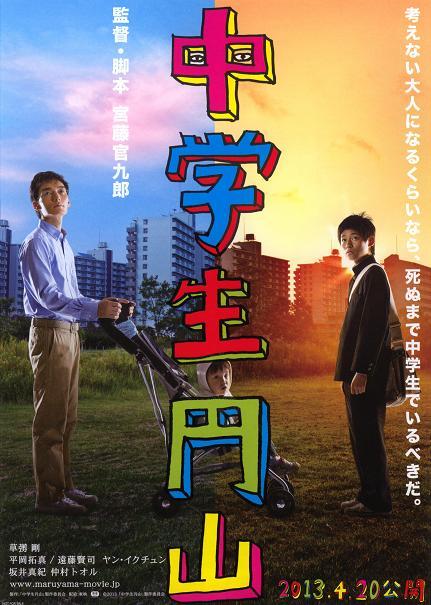
Everyone’s feeling somewhat uncomfortable now.
Okay, so what would you think if I told you that Maruyama, the main character in this film, spends most of the film trying to touch tongue to his own peen? A certain expectation will be set, wouldn’t it? Like, there wouldn’t be much else to expect from the plot except whether that lollypop gets licked. So it’s pleasantly surprising to find that it’s actually less like a string of dick jokes (unlike this review), and more of an endearingly quirky film.
Our hero with a quest, Maruyama, is a hormonal 14-year-old with a rather active imagination, frequently dreaming up imagined lives for his family and residents of his apartment complex. We’re taken through his daydreams, which range from randy fantasies filled with bouncy ladies, to colourful scenarios that get sillier and funnier as he imagines various people being either wacky fruit-themed superheroes, scissor-wielding gangsters or aliens. But Maruyama decides that he needs a hobby to distract him from such childish preoccupations, one that will bring focus and maturity – like attempting to orally do one’s own dong. However, he later befriends a dorky, uncharismatic single father, Shimoi (played with surprising ability by Tsuyoshi Kusanagi, a member of the ageless Japanese boy band SMAP), who encourages him to embrace his fantasies. Real life can be more strange than any fantasy, and a bit of strangeness is nothing to be ashamed of, but celebrated.
Maruyama’s world is undeniably ridiculous and entertaining (and sometimes sticky) as the imagination of a teen could be. And despite Maruyama’s overarching ambition to boldly try what many men have tried before (and failed, and the few that do make a career out of it), a sweet, innocent quality exists, thanks to director Kankuro Kudo’s affectionate treatment of him and all the eccentric and flawed characters that populate the neighbourhood. It’s quite an accomplishment that “Maruyama” manages to build a more substantial film on such an unlikely basis, and it results in a film that’s like a funnier combination of a Wes Andersen and Michel Gondry movie. Hiraoka Takuma, being close to the age of the character Maruyama that he plays, embodies the innocence and determined Maruyama well, shining with youthful enthusiasm, embarrassment and determination as he takes his character from zero to hero. The whole ensemble cast is perfect in their various roles, obviously having a lot of fun, from Kenji Endo’s geriatric grandfather with a surprising ability, and Maki Sakai as Maruyama’s Korean drama-obsessed mother.
It’s hard for any film to sustain the initial novelty of the first half right to the end, and “Maruyama” suffers the same problem as it gets a bit flaccid towards the end. However, the film still climaxes in a satisfactory way that, while lacking in the same vigor and energy of the start, manages to tie up all the plot threads and situations. While “Maruyama’s” length is a bit too long for comfort, overall, it charms with its humor and originality – not bad for a film that started off with auto-fellatio.
Maruyama the Middle Schooler (Chuugakusei Maruyama) by Kankuro Kudo, released in Japan April 21 2013, starring Tsuyoshi Kusanagi, Hiraoka Takuma, Kenji Endo, Yang Ik-June, Maki Sakai, Toru Nakamura, Nanami Nabemoto, Yuiko Kariya
“Reunion” – Film Review from Australia’s 17th Japanese Film Festival
Australia’s 17th Japanese Film Festival is soon embarking on its last city tour in Melbourne, the capital of the southern state of Victoria, after being shown around Australia in the first ever national film festival administered by the Japan Foundation. Eden Law (Fukushima-ken ALT 2010-2011, current JETAA NSW committee member) got to see some of what’s on offer during its recent run in Sydney. This one’s for you, Melbournites! Don’t say we don’t do anything for you south of the border.
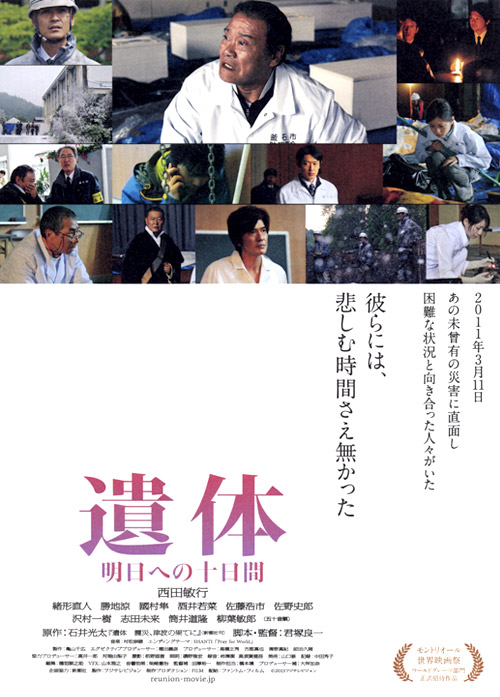
If you can’t feel anything watching this, you are probably dead inside.
It has been almost three years since the disaster that devastated the north of Japan. There have since been a handful of films on the event, on the nation and it’s people as they resolutely look forward to “revival” and reconstruction. However, few of those films, I suspect, would have dealt quite so starkly and closely on the subject of death quite like “Reunion”.
“Reunion” is a dramatization of Itai: Shinsai, Tsunami no Hate ni (遺体―震災、津波の果てに?, “The Bodies at the End of the Earthquake and Tsunami”), a reportage of the events by Kota Ishii in the days immediately following the earthquake and tsunami of March 11. A brief snapshot of the normal, mundane lives around town in the beginning, contrasts sharply the aftermath, showing how unprepared and ill-equipped the small town’s public servants were, as bodies kept coming into the temporary morgue set up in the old high school gymnasium, and distraught relatives plead for information and support. Horrified by the disorganization and haphazard treatment of the dead, Aiba (played by Toshiyuki Nishida), a retired funeral home director, volunteers to oversee the proper administration of the morgue. He shows the exhausted and numbed workers how to massage limbs stiffened by rigor mortis until they became pliant again for proper positioning, and how to counsel and deal with the grieving and traumatized people who come to identify the deceased. And slowly, people carry on with their jobs, because there is very little other choice.
This will be the most heart-breaking film you’ll ever watch this year. I’ve never cried at the movies before (if there’s anybody watching), but looks like there’s the first time for everything. While the subject matter itself is undeniably powerful and emotional, “Reunion” is actually quite simple, a recounting of the events and the personal tragedies of those who survived. Music is used sparingly in this film, the silence heightening the solemnity and noises that included the constant squelching of the mud-logged boots and the sobs of the bereaved, background sounds as described in the book. Director Ryoichi Kimizuka makes sure that the deceased is an all-pervasive presence, as the cast of characters work with them and around them, uncovering their blackened swollen faces, identifying them and saying prayers for their souls. Thanks to Aiba’s character, not only are the workers brought around to empathise with the dead, as their names and personal stories are revealed, but the audience also becomes involved. Little wonder then, that at many events where this film has been screened, audiences have been emotionally devastated.
In this film where multiple stories and tragedies play out, the cast work marvellously well together. There are very little histrionics or hysteria, just numbed helplessness, as many at first wander confusedly about before being given direction by Aiba. Performances are muted and restrained, which make the break-down moments even more heart-wrenching, for everyone has their trigger, be it the discovery of a loved one’s body while carrying out work, or the tragedy of a young child, unclaimed by any surviving relatives. There are no questions of morality, no “why did this happen to us”, soul-searching, condemnation or religious debate to be had that can be adequate. From Aiba’s point of view however, the answer is to never forget one’s humanity, which can be even more precious than food, in order to survive the unrelenting horror and sorrow of the situation. And that in the end, ultimately provides a glimmer of positivity in this film, as well as in life.
Reunion (Itai: Shinsai, Tsunami no Hate ni) by Ryoichi Kimizuka, released in Japan February 23 2013, starring Toshiyuki Nishida, Naoto Ogata, Ryo Katsuji, Jun Kunimura, Wakana Sakai, Tsuneo Aiba, Kenichi Domon, Yuta Oikawa, Yoshito Shibata, Takae Oshita, Koichi Sato, Shiro Sano, Ikki Sawamura, Mirai Shida, Michitaka Tsutsui, Michio Shimoizumi, Takeshi Yamaguchi, Nobutsugu Matsuda, Yuko Terui, Daisuke Hiraga, Toshiro Yanagiba
“Brain Man” – Film Review from Australia’s Japanese Film Festival
Australia’s 17th Japanese Film Festival is soon embarking on its last city tour in Melbourne, the capital of the southern state of Victoria, after being shown around Australia in the first ever national film festival administered by the Japan Foundation. Eden Law (Fukushima-ken ALT 2010-2011, current JETAA NSW committee member) got to see some of what’s on offer during its recent run in Sydney. This one’s for you, Melbournites! Don’t say we don’t do anything for you south of the border.
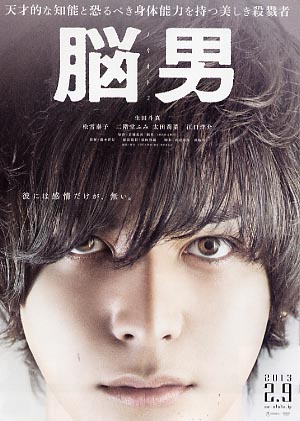
Doumo arigatou Mr Roboto
At times graphically brutal and sadistic, “Brain Man” moves at a brisk pace, frequently keeping the audience off-balance with unsettling scenes and stylistic ideas that are reminiscent of other films in the genre. An adaptation of the novel “No Otoko” by Urio Shudo, the novel itself won the 2000 Edogawa Rampo Award for newcomers to crime fiction. In it, a series of sadistic murders and explosions pressures the police lead by Detective Chaya (Yosuke Eguchi, who must be channelling every crusty, grouchy detective character ever to exist in film) to find the culprits responsible, and soon enough Ichiro (Toma Ikuta) is apprehended as the prime suspect. However, things are rather decidedly odd about Ichiro, who is more like a robot than a human, going like clockwork to… go, unable to feel pain or emotion. Although in peak physical condition (via an establishing shot as the camera lingers over Toma’s skinny yet hard-bodied torso, which is itself inhumanly bereft of fat), he is clearly a special psychiatric case, which is where Dr Washiya (Yasuko Matsuyuki), a brilliant psychiatrist, comes in to help with police investigation. Although like other characters in the film, she herself carries a trauma, that fuels her determination to investigate and uncover the truth about Ichiro, and ultimately the case.
This film calls for a certain suspension of disbelief – probably more than usual, with the number of implausibilities it has. This is not a film that is completely grounded in reality, even given the premise of a serial-bomber-Saw-wannabe and a man-bot. However, that’s not to say it’s done badly. Director Tomoyuki Takimoto excels at creating a tense, unsettling atmosphere, typically using lots of dark cold colours that’s grim and claustrophobic, even in the day scenes. There are unexpected shocks punctuating the film at a brisk pace, creating a sense of dangerous unpredictability for the characters. Takimoto doesn’t shy away from being graphic either, what with body parts being ripped, stabbed, shredded or sliced merrily in some form or another, in sadistically creative ways. Some of the characters and baddies are suitably over the top (especially Fumi Nikaido and Rina Ohta as Noriko and Yuria, in deliciously scenery-chewing performances), though are a little obscure in their motivation. But whatever man, they’re totes cray-cray – who can understand why they do the things they do.
But that sort of unreality element can work against it, especially when the film, in the form of Dr Washiya, seems to be exploring more serious and unexpectedly philosophical issues: can a person be rehabilitated, or their basic nature changed? In the beginning of the film, Dr Washiya advocates a new form of “narrative” therapy to habilitate hardened criminals, contrary to the accepted methods of the establishment. It’s a theme that surfaces once in a while throughout the film, although largely overwhelmed by the more exciting and visceral violence and terror. But during those moments, Matsuyuki (as the doctor) does really well in giving her character the right mix of toughness and vulnerability, and her interaction with a “cured” patient, brings a totally different kind of disturbing creepiness thanks in no small part to Shota Sometani who plays Shimura, the patient in question. But these differences seem out of place in a film that’s usually more thrills and spills, in a world where a grizzled no-nonsense detective has long hair and the living coin-operated boy somehow has access to a great hair stylist and chic clothes.
However, as mentioned, “Brain Man” is still done well and is highly enjoyable to watch, especially if you’re a fan of the thriller/crime/mystery genre. As Ichiro, Toma Ikuta’s highly restrained acting, communicating only through subtle body language and stares, is quite absorbing. And “Brain Man” manages to deliver right to the end, as a final emotional shock is revealed.
PS: Bonus points for the ending credit song: “21st Century Schizoid Man” by King Crimson!
Brain Man (No Otoko) by Tomoyuki Takimoto, released in Japan February 9 2013, starring Toma Ikuta, Yasuko Matsuyuki, Yosuke Iguchi, Fumi Nikaido and Rina Ohta.
JQ Magazine: JETAA USA Earthquake Relief Fund Aids Recovery

Taylor Anderson Memorial Fund founder Andy Anderson (center) with members of the JET Alumni Association of New York at Columbia University, Oct. 30, 2013. (Courtesy of JETAA New York)
By C-M Daeley (Saga-ken, 2008-2011) for JQ magazine. C-M is a poet, rap lyricist, and travel enthusiast currently working as an English teacher in Tokyo. For a look at some of his other writing, poetry and lyrics, check out his blog at http://spikedaeley.wordpress.com.
With today’s 24-hour global news cycle, it is sometimes difficult to keep even the most severe events in public memory. The Great East Japan Earthquake that struck on March 11, 2011 has not received much recent coverage in global news, but the issues faced by those still rebuilding remain monumental. Fortunately, there has been significant international aid from a number of sources, one of which is the JETAA USA Earthquake Relief Fund. This grant has raised almost USD $90,000 and has been used to provide seed funding to assist grassroots programs in areas severely impacted by the earthquake.
Due to the complex nature of fund allocation, this article will focus mainly on projects and programs directly supported through JETAA funds. However, it is significant to note that the Earthquake Relief Fund was only one of several avenues used to bring aid to the region and that, to date, roughly $500,000 has been raised through JET-affiliated groups and organizations worldwide. Jim Gannon (Ehime-Ken, 1992-94), current executive director at the Japan Center for International Exchange in New York, and Jessyca Livingston (Hokkaido, 2003-06), one of the three JETAA USA Country Representatives serving during the immediate aftermath and current JET Program coordinator at the Consulate-General of Japan in Denver, spoke about some of the initiatives the Earthquake Relief Fund has helped support.
“It is very difficult to give a concise yet comprehensive picture of what the JETAA funds have done,” Gannon explained. “The best way to describe it is that they have played a catalytic role in supporting some key projects in the early stage that have been supported by a range of others in more generous fashion once they proved their merits. JETAA cannot take full credit for all of the successes, but it did play an important role in getting things moving.” He also noted, “The real heroes are these incredible people from Tohoku who have championed these projects, the inspirational young people who have relocated to Tohoku to help operate them, and those who have been shuttling back and forth from Tokyo and elsewhere to help formulate and drive these initiatives.”
After a national discussion and several rounds of voting in each of JETAA USA’s 19 chapters, a final decision was made about how the fund should be allocated. “In the end, it was very obvious that chapters found it important to support education-related efforts in those areas most affected,” Livingston said.
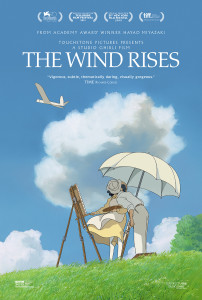
“The Wind Rises is a combination of everything that makes Studio Ghibli as we know it today. It also adds several new elements which make this film dynamic and, some say, controversial.” (Touchstone Pictures)
By Alexis Agliano Sanborn (Shimane-ken, 2009-11) for JQ magazine. Alexis is a graduate of Harvard University’s Regional Studies—East Asia (RSEA) program, and currently works as an executive assistant at Asia Society in New York City.
Written and directed by Hayao Miyazaki, The Wind Rises is like no Studio Ghibli movie I have ever seen. No. Wait. It’s like every Ghibli movie I have ever seen. You want fantasy? You got it. You want airships à la Castle in the Sky or Nausicaä of the Valley of the Wind? You got it. You want deliciously portrayed food? You want nostalgic scenery from bygone days of Tokyo or picturesque European towns? You got that, too. The Wind Rises is a combination of everything that makes Ghibli as we know it today. It also adds several new elements which make this film dynamic and, some say, controversial.
One of the most differentiating factors is that The Wind Rises is the only full-length feature to focus on an actual historical figure—Jiro Horikoshi, the designer of the Mitsubishi A5M, a fighter aircraft of World War II. Granted, Miyazaki used his artistic license to embellish the narrative—but he does that only to make things more beautiful and fantastical. (And that’s why we love Miyazaki, right?)
Watching The Wind Rises, you feel repeatedly—and indeed the entire plot more or less focuses on—Japan’s desperation to achieve modernity according to “Western standards.” But modernization was not a smooth road, and Miyazaki makes that message clear. Despite the beautiful veneer, the crux of this film lies in the frustration of a country and its people. Economic deflation, poverty, and limited resources repeatedly arise as roadblocks. (This may explain part of the reason for its amazing popularity in Japan. Frustrations, impatience and desperation exist within every generation.) Yet, as Jiro is reminded, even with setbacks and disappointments, one must live on and progress despite it all.
JQ Magazine: Australia Unfolds Its 17th Japanese Film Festival
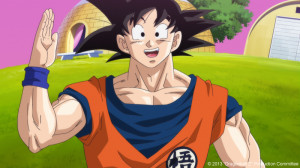
The new Dragon Ball Z: Battle of Gods hits six cities in Australia as part of its 17th Japanese Film Festival continuing in October through December. (Dragon Ball Z Production Committee)
By Eden Law (Fukushima-ken, 2010-11). After the JET Programme more than fulfilled its promise of “an experience of a lifetime,” Eden returned to Sydney, Australia, where he joined the JETAA New South Wales chapter to take advantage of the network and connections available to undertake projects such as an uchiwa design competition for the Sydney Japan Festival. He also maintains the JETAANSW website and social media. Other than that, he’s a web designer and a poet, gentlemen and raconteur.
Like a springtime wave of hanami Down Under, the 17th Japanese Film Festival began showing in staggered releases nationally in Australia, blooming first in Broome in late September, before displaying a full bouquet of film delights in the major metropolitan areas of Sydney and Melbourne. This is the first time that the festival has launched a national program, ranging from a mini ensemble of three films for small towns like Broome and Cairns, to a behemoth 33 new films and five classics in major cities like Melbourne and Sydney, which means the festival will run from 17 Sep to 8 Dec as it tours around Australia. Many of the new films will be shown for the first time in Australia (aw, you spoil us, Japan Foundation, you really do!). In addition, at this time of writing, the five classics will be shown for free, allowing even the most penniless hipster to get a gander and drop a casual mention at the right fashionable dinner parties.
With so many new films, many of which aren’t known outside of Japan (trust me, I’ve Googled this), how will you know which to watch and be informed like the sophisticate that you no doubt are? Well, for a start, check out the screening schedules for all the films in your (nearest) city. But fret not, gentle reader, for I shall explore some of the selections on show.
Based on a True Story
Documentaries and dramatisations based on true stories feature strongly in this year’s program. A Boy Called H, which won Special Prize at the Moscow International Film Festival 2013, is based on Kappa Senoh’s best-selling autobiography about growing up in World War II-era Kobe. Closing some of the larger programs, Fruits of Faith is based on a novel inspired by a true story of a fruit grower who tries to achieve the impossible dream of the perfect crop of organic apples, despite skepticism and threat of bankruptcy. Reunion, based on a journalist’s accounts, is an illustration of how individuals strive to retain their humanity and compassion in the face of unrelenting misery and death in the wake of the Tohoku disaster. Leaving no eye dry at last year’s Montreal Film Festival, it’s a good way to see if life has yet to crush all feelings out of your bitter husk. And for anyone who has ever treasured a truly good bowl of ramen (especially after a long night of clubbing in Tokyo—the Japanese equivalent to our 4 a.m. kebab), the documentary The God of Ramen will inspire not just food lovers, but anyone who’s ever had an all-consuming (hah!) passion.

